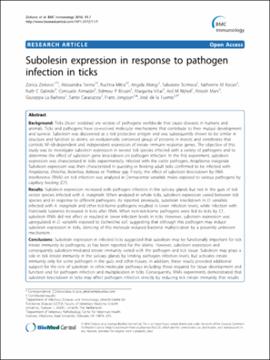| dc.contributor.author | Zivkovic, Zorica | |
| dc.contributor.author | Torina, Alessandra | |
| dc.contributor.author | Mitra, Ruchira | |
| dc.contributor.author | Alongi, Angela | |
| dc.contributor.author | Scimeca, Salvatore | |
| dc.contributor.author | Kocan, Katherine M. | |
| dc.contributor.author | Almazan, Consuelo | |
| dc.contributor.author | Blouin, Edmour F. | |
| dc.contributor.author | Villar, Margarita | |
| dc.contributor.author | Nijhof, Ard M. | |
| dc.contributor.author | Mani, Rinosh | |
| dc.contributor.author | La Barbera, Giuseppa | |
| dc.contributor.author | Caracappa, Santo | |
| dc.contributor.author | Jongejan, Frans | |
| dc.contributor.author | de la Fuente, Jose | |
| dc.date.accessioned | 2019-08-21T22:01:36Z | |
| dc.date.available | 2019-08-21T22:01:36Z | |
| dc.date.issued | 2010-02-19 | |
| dc.identifier | oksd_zivkovic_subolesinexpres_2010 | |
| dc.identifier.citation | Zivkovic, Z., Torina, A., Mitra, R., Alongi, A., Scimeca, S., Kocan, K. M., ... de la Fuente, J. (2010). Subolesin expression in response to pathogen infection in ticks. BMC Immunology, 11, Article 7. https://doi.org/10.1186/1471-2172-11-7 | |
| dc.identifier.uri | https://hdl.handle.net/11244/321215 | |
| dc.description.abstract | Background: Ticks (Acari: Ixodidae) are vectors of pathogens worldwide that cause diseases in humans and animals. Ticks and pathogens have co-evolved molecular mechanisms that contribute to their mutual development and survival. Subolesin was discovered as a tick protective antigen and was subsequently shown to be similar in structure and function to akirins, an evolutionarily conserved group of proteins in insects and vertebrates that controls NF-kB-dependent and independent expression of innate immune response genes. The objective of this study was to investigate subolesin expression in several tick species infected with a variety of pathogens and to determine the effect of subolesin gene knockdown on pathogen infection. In the first experiment, subolesin expression was characterized in ticks experimentally infected with the cattle pathogen, Anaplasma marginale. Subolesin expression was then characterized in questing or feeding adult ticks confirmed to be infected with Anaplasma, Ehrlichia, Rickettsia, Babesia or Theileria spp. Finally, the effect of subolesin knockdown by RNA interference (RNAi) on tick infection was analyzed in Dermacentor variabilis males exposed to various pathogens by capillary feeding (CF). | |
| dc.description.abstract | Results: Subolesin expression increased with pathogen infection in the salivary glands but not in the guts of tick vector species infected with A. marginale. When analyzed in whole ticks, subolesin expression varied between tick species and in response to different pathogens. As reported previously, subolesin knockdown in D. variabilis infected with A. marginale and other tick-borne pathogens resulted in lower infection levels, while infection with Francisella tularensis increased in ticks after RNAi. When non-tick-borne pathogens were fed to ticks by CF, subolesin RNAi did not affect or resulted in lower infection levels in ticks. However, subolesin expression was upregulated in D. variabilis exposed to Escherichia coli, suggesting that although this pathogen may induce subolesin expression in ticks, silencing of this molecule reduced bacterial multiplication by a presently unknown mechanism. | |
| dc.description.abstract | Conclusions: Subolesin expression in infected ticks suggested that subolesin may be functionally important for tick innate immunity to pathogens, as has been reported for the akirins. However, subolesin expression and consequently subolesin-mediated innate immunity varied with the pathogen and tick tissue. Subolesin may plays a role in tick innate immunity in the salivary glands by limiting pathogen infection levels, but activates innate immunity only for some pathogen in the guts and other tissues. In addition, these results provided additional support for the role of subolesin in other molecular pathways including those required for tissue development and function and for pathogen infection and multiplication in ticks. Consequently, RNAi experiments demonstrated that subolesin knockdown in ticks may affect pathogen infection directly by reducing tick innate immunity that results in higher infection levels and indirectly by affecting tissue structure and function and the expression of genes that interfere with pathogen infection and multiplication. The impact of the direct or indirect effects of subolesin knockdown on pathogen infection may depend on several factors including specific tick-pathogen molecular interactions, pathogen life cycle in the tick and unknown mechanisms affected by subolesin function in the control of global gene expression in ticks. | |
| dc.format | application/pdf | |
| dc.language | en_US | |
| dc.publisher | BioMed Central | |
| dc.rights | This material has been previously published. In the Oklahoma State University Library's institutional repository this version is made available through the open access principles and the terms of agreement/consent between the author(s) and the publisher. The permission policy on the use, reproduction or distribution of the material falls under fair use for educational, scholarship, and research purposes. Contact Digital Resources and Discovery Services at lib-dls@okstate.edu or 405-744-9161 for further information. | |
| dc.title | Subolesin expression in response to pathogen infection in ticks | |
| osu.filename | oksd_zivkovic_subolesinexpres_2010.pdf | |
| dc.description.peerreview | Peer reviewed | |
| dc.identifier.doi | 10.1186/1471-2172-11-7 | |
| dc.description.department | Veterinary Pathobiology | |
| dc.type.genre | Article | |
| dc.type.material | Text | |
| dc.subject.keywords | animals | |
| dc.subject.keywords | antigens | |
| dc.subject.keywords | arthropod proteins | |
| dc.subject.keywords | bacteria | |
| dc.subject.keywords | bacterial infections | |
| dc.subject.keywords | dermacentor | |
| dc.subject.keywords | drosophila proteins | |
| dc.subject.keywords | evolution, molecular | |
| dc.subject.keywords | host-pathogen interactions | |
| dc.subject.keywords | immunity, innate | |
| dc.subject.keywords | insect vectors | |
| dc.subject.keywords | intestines | |
| dc.subject.keywords | life cycle stages | |
| dc.subject.keywords | rna, small interfering | |
| dc.subject.keywords | salivary glands | |
| dc.subject.keywords | ticks | |
| dc.subject.keywords | virulence | |
| dc.subject.keywords | akirin1 protein, drosophila | |
| dc.subject.keywords | antigens | |
| dc.subject.keywords | arthropod proteins | |
| dc.subject.keywords | drosophila proteins | |
| dc.subject.keywords | rna, small interfering | |
| dc.subject.keywords | subolesin, tick | |
